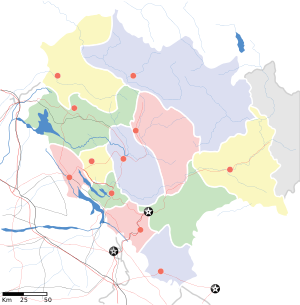Jawalamukhi
| Jawalamukhi Jawalaji | |
|---|---|
| city | |
 | |
 Jawalamukhi  Jawalamukhi Location in Himachal Pradesh, India | |
| Coordinates: 31°53′N 76°19′E / 31.88°N 76.32°ECoordinates: 31°53′N 76°19′E / 31.88°N 76.32°E | |
| Country |
|
| State | Himachal Pradesh |
| District | Kangra |
| Elevation | 610 m (2,000 ft) |
| Population (2001) | |
| • Total | 4,931 |
| Languages | |
| • Official | Hindi |
| Time zone | IST (UTC+5:30) |
Jawalamukhi is a town and a nagar parishad in Kangra district in the Indian state of Himachal Pradesh.
Geography
Jawalamukhi is located at 31°53′N 76°19′E / 31.88°N 76.32°E.[1] It has an average elevation of 610 metres (2,001 feet).
Demographics
At the 2001 India census,[2] Jawalamukhi had a population of 4931. Males constitute 52% of the population and females 48%.
Area Profile of Jawalamukhi Town
As of 2001 India census,[2]
- Number of Households - 1,012
- Average Household Size (per Household) - 5.0
- Population-Total - 4,931
- Population-Urban - 4,931
- Proportion of Urban Population (%) - 100
- Population-Rural - 0
- Sex Ratio - 906
- Population (0-6Years) - 608
- Sex Ratio (0-6 Year) - 961
- SC Population - 812
- Sex Ratio (SC) - 961
- Proportion of SC (%) - 16.0
- ST Population - 0
- Sex Ratio (ST) - 0
- Proportion of ST (%) - 0
- Literates - 3,777
- Illiterates - 1,154
- Literacy Rate (%)
Jwalamukhi Devi Temple
Jwalamukhi is a famous temple to the goddess Jwalamukhi, the deity of flaming mouth. Raja Bhumi Chand Katoch of Kangra, a great devotee of goddess Durga, dreamt of the sacred place and the Raja set people to find out the whereabouts of the site. The site was traced and the Raja built a temple at that location.[3] The building is modern with a gilt dome and pinnacles, and possesses a beautiful folding door of silver plates. Under the gaze of the Dhauladhar range and set amidst the undulating hills that character sub-Himalayan Himachal Sati's tongue is believed to have fallen at Jwalamukhi and the goddess is manifest as tiny flames that burn a flawless blue through fissures in the age old rock.
The temple located on a small spur on the Dharamsala-Shimla road at a distance of about 20 km from the Jwalamukhi Road Railway Station attracts hundreds of thousands of pilgrims every year. No idol is located in the temple and the deity is worshipped in the form of flames which come out from the crevices of the rock. There is a small platform in front of the temple and a (check usage) big mandap where a huge brass bell presented by the King of Nepal is hung. Usually milk and water are offered and the ahutis or oblations are offered to the sacred flames in the pit, situated in the centre of the temple in between the floor pillars supporting the roof.
The deity is offered Bhog of Rabri or thickened milk, Misri or candy, seasonal fruits, milk. There is a mystic Yantra or diagram of the goddess, which is covered with, shawls, ornaments and mantras are recited. The puja has different 'phases' and goes on practically the whole day. Aarti is performed five times in the day, havan is performed once daily and portions of Durga Saptasati are recited. The temple is closed from 11.30am to 12.30pm for Aarti. The Mughal Emperor Akbar, on learning about the legends of Jwalamukhi, tried to douse the flames with a stream of water but could not succeed in doing so. Out of reverence, Akbar offered a Gold umbrella (Chatra) to the Goddess, but the umbrella turned into an unknown metal suggesting that the Goddess did not accept his offering.[4]
Maharaja Ranjit Singh paid a visit to the temple in 1815 and the dome of the temple was gold-plated by him. Just a few feet above the Jwalamukhi temple there is a six-feet deep pit with a circumference of about three-feet. At the bottom of this pit there is another small pit about one and a half feet deep with hot water bubbling all the time.
The temple is identified as one among the 52 Shakti Peethas. It is also one of the most renowned temples of Goddess Durga.[5]
The Jwalamukhi shrine as a Shakti Peeth

The shrine is regarded as a Maha Shakti Peetham. It is believed that Sati Devi's tongue fell here. Shakti Peethas are shrines of Devi, the primodial Mother Goddess. Each Shakti Peetha has a shrine for the Shakti and Bhairava. Siddhida (Ambika)is the Shakti and Unmatta Bhairava is the Kalabhairava. The mythology of Daksha yaga and Sati's self immolation had immense significance in shaping the ancient Sanskrit literature and even had impact on the culture of India. It led to the development of the concept of Shakti Peethas and there by strengthening Shaktism. Enormous mythological stories in puranas took the Daksha yaga as the reason for its origin. It is an important incident in Shaivism resulting in the emergence of Shree Parvati in the place of Sati Devi and making Shiva a grihastashrami (house holder).[6][7][8]
References
- ↑ Falling Rain Genomics, Inc - Jawalamukhi
- 1 2 "Census of India 2001: Data from the 2001 Census, including cities, villages and towns (Provisional)". Census Commission of India. Archived from the original on 2004-06-16. Retrieved 2008-11-01.
- ↑ www.himachalhillstations.com/jawala-ji.html
- ↑ www.culturalindia.net/indian-temples/jwala-devi-temple.html
- ↑ www.durga-puja.org/jwalamukhi-temple.html
- ↑ (Translator), F. Max Muller (June 1, 2004). The Upanishads, Vol I. Kessinger Publishing, LLC. ISBN 1419186418.
- ↑ (Translator), F. Max Muller (July 26, 2004). The Upanishads Part II: The Sacred Books of the East Part Fifteen. Kessinger Publishing, LLC. ISBN 1417930160.
- ↑ "Kottiyoor Devaswam Temple Administration Portal". http://kottiyoordevaswom.com/. Kottiyoor Devaswam. Retrieved 2013-07-20. External link in
|work=(help)